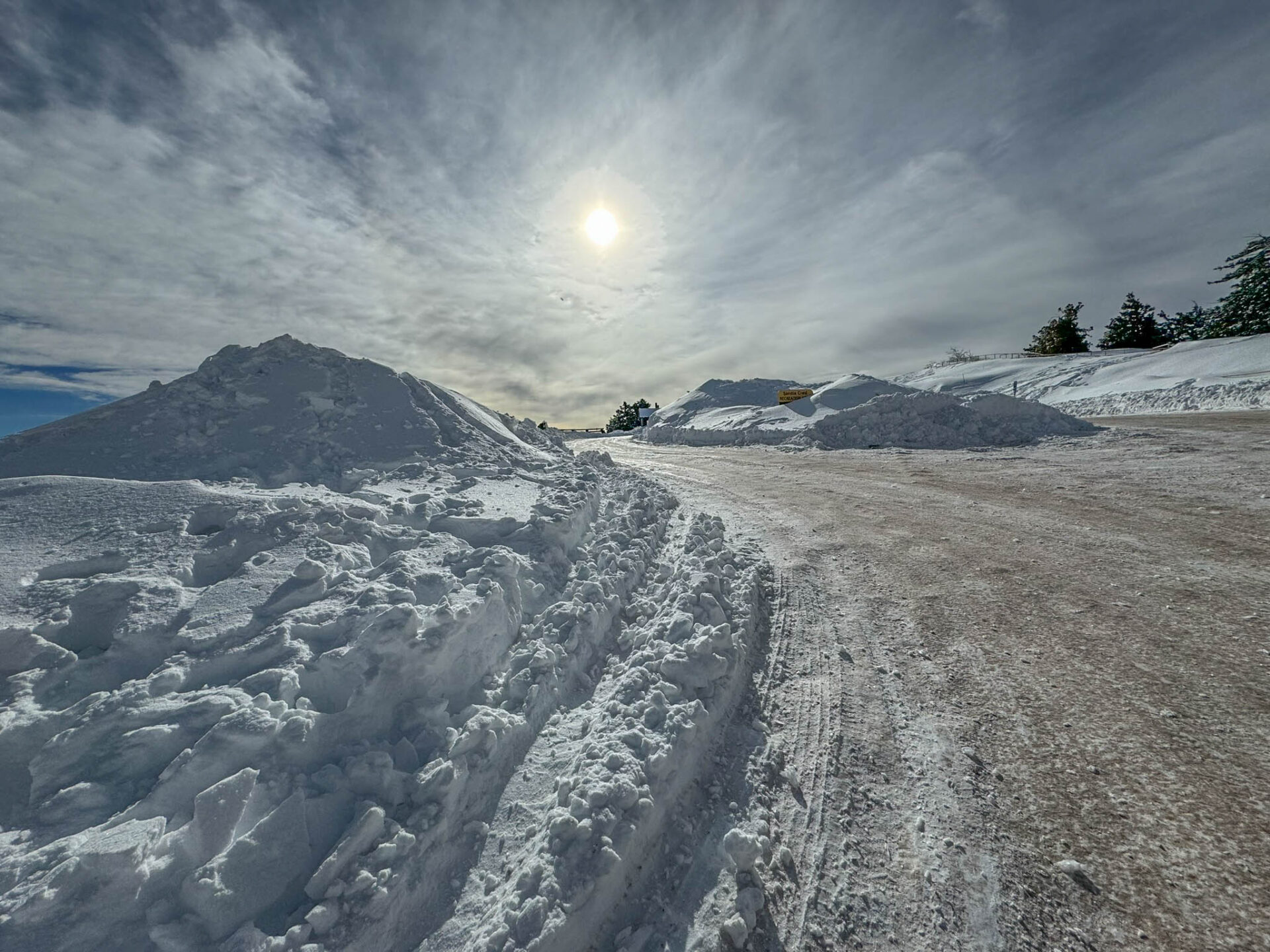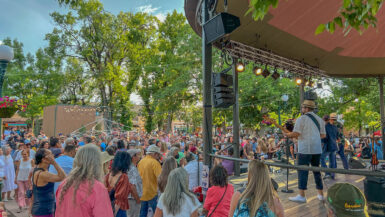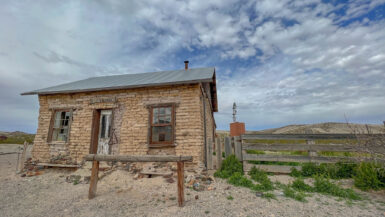A Guide to Spotting Rosy-Finches and Other High-Elevation Birds in the Sandia Mountains
Ascending a narrow mountain road to 10,678 feet in the dead of winter isn’t exactly high on most people’s weekend getaway lists—unless skis, snowboards, or snowshoes are involved. But birders? They’re a different breed. Give them a half-decent chance of spotting something rare, and they’ll happily drive through sleet, ice, and existential doubt.
Now, I’m not one of those list-chasing birdwatchers who can recite their life tally by zip code. But I do enjoy birds, and I’m not above a little seasonal obsession. So there I was—again—winding my way up to Sandia Crest for the second time in two weeks, hoping to catch a glimpse of some winter legends: the elusive rosy-finches, a possible three-toed woodpecker, maybe a red crossbill or Clark’s nutcracker thrown in for good measure.
Here’s how it went.

Table of Contents
Heads up: Some of the links in this post are affiliate links. If you buy something through them, it helps support this site—at no extra cost to you. I only recommend stuff I genuinely use and trust.
Where Is Sandia Crest, and How Do I Get There?
First things first—let’s cover the basics: Where exactly is Sandia Crest? What the heck is a rosy-finch? And why are birders so obsessed with them?
Sandia Crest vs. Sandia Peak
If you’re standing in Albuquerque, New Mexico, and look east, you’ll see the Sandia Mountains rising above the city. At the summit, you might spot a cluster of radio towers—that’s Sandia Crest, often just called “The Crest.” It’s the true summit of the range, sitting at 10,678 feet. Fun fact: it’s not technically in Albuquerque at all—it’s in the small town of Sandia Park, which also happens to be the same East mountain community I call home.
Now, if you hear someone mention “Sandia Peak,” they’re probably talking about the upper terminal of the Sandia Peak Aerial Tramway, which tops out at 10,378 feet. That’s not the same as Sandia Crest—the true summit of the Sandia Mountains at 10,678 feet—though the two terms are often used interchangeably. They’re close (about two miles apart), but not the same spot.
If you’re curious about the Sandia Peak Aerial Tramway and want to learn more about Sandia Peak and Sandia Crest—as well as the geology, history, and future of the Sandia Mountains—I wrote a separate article you can check out here: Experience Albuquerque from Above: The Sandia Peak Aerial Tramway.

How Do You Get to Sandia Crest?
You’ve got three main options:
- Option 1: Drive: Hop in the car and take the scenic route around the back of the Sandia Mountains to the area known as the East Mountains. From Albuquerque, take I-40 East to Tijeras, then head north on Highway 14 (aka the Turquoise Trail) for about 6 miles. At the roundabout, take the left turn onto Sandia Crest Scenic Highway and follow it 13.3 miles to the summit. If you’re starting from downtown Albuquerque, the whole drive takes just under an hour.
- Option 2: Strenuous Hike: If you’re up for a challenge, you can hike to Sandia Crest from one of several trailheads—either on the Albuquerque side (like La Luz Trailhead) or from the East Mountains. Expect a steep climb and some serious elevation gain.
- Option 3: Take the Tram (Sort Of): Here’s the catch: the tram doesn’t actually take you to Sandia Crest. It drops you off at Sandia Peak, near the Ten 3 restaurant, at 10,378 feet. From there, it’s a 1.75-mile one-way hike along the crest trail to reach the bird feeder at the Sandia Crest House. After you’ve had your fill of feathered friends, you’ll do it all in reverse—or commit to a much longer hike down the mountain.
For this article, I’m focusing on Option 1: the drive to the summit.

The Drive to Sandia Crest
Unless you’re one of those motorcycle riders who treats the Sandia Crest Scenic Highway like a racetrack, it’ll probably take you just under 30 minutes to drive up—and another 30 to get back down—from the intersection of Highway 14 and the Crest Road.
In the summer, you’ll likely pass plenty of cyclists grinding their way up the long climb to the summit, rewarded by a high-speed descent on the way back down. In the winter? Not so much.
Before you head out, it’s a good idea to check road conditions. Snow and ice can make things sketchy fast, and weather at the top of Sandia Crest is often wildly different from what you’ll find in downtown Albuquerque.
On my two recent drives (December 26 and January 1), the roads were mostly in decent shape—but I did hit several icy patches along the way.

On my way up the mountain one New Year’s morning, I passed a car that had taken a creative approach to “riding the rails” during its descent from Sandia Peak. It was still early and no one was around, so I’m guessing it happened the night before—maybe a little New Year’s Eve enthusiasm gone sideways. Either way, it’s a good reminder to take it slow on this road, especially if you’re not driving a 4WD or AWD vehicle.



Parking at the Summit
Whew, you made it!
At the top, you’ll have two options: turn left into a large parking lot, or continue up to a small loop where people sometimes drop off passengers at the Crest House or the scenic overlook.
Unfortunately, the Crest House is no longer open—and from what I’ve heard, there aren’t any plans to reopen it anytime soon.
If you’re here for the birds, you’ll want to park near the far end of the large lot—close to the distant white car in the photo below. That’s the sweet spot.

As you drive toward the far end of the parking lot, you may notice a few cars parked facing uphill. Chances are, those are birders watching the feeder from the comfort (and warmth) of their vehicles.

There are several pay stations at the summit: $3 per vehicle for a day pass, or $10 for high-occupancy vehicles with 15+ passengers—unless you have a New Mexico Enchantment Pass or other approved pass.
These aren’t fancy machines that take cards or give change. It’s the old-school method: grab an envelope, write down your info, insert your payment, seal it up, and drop it in the slot. No staff on site to make change, but there are folks who make the rounds to issue tickets for anyone who skips the process.

Birding Sandia Crest
Nearly 250 bird species have been recorded in the Sandia Mountains. To help you identify them, the Sandia Ranger District of the Cibola National Forest created a handy checklist called Birds of the Sandia and Manzanita Mountains—a great resource for anyone looking to explore the local birdlife.
Now that you’ve got a sense of what might be out there, let’s get specific. If you’re heading to the summit for some winter birdwatching, chances are you’re after one thing: the famous feeder that draws in those elusive rosy-finches.
Let’s take a closer look at that spot.
“The Bird Feeder”
If you’re looking for rosy-finches, you’re looking for the feeder—the one maintained by dedicated Audubon Society volunteers and other local birding enthusiasts. If you’d like to help keep the feeder stocked for the finches, please use only no-mess, shelled sunflower seed that won’t germinate. This is a U.S. Forest Service requirement to prevent the spread of nonnative plants.
There used to be additional feeders on the far side of the Sandia Crest House when it was open, but since the business closed, only one remains. You’ll find it just uphill from the parking lot, and it’s your best bet for spotting all three species of rosy-finch in winter.

The first species I saw on the feeder during my visit was… drumroll, please…

Before I go any further, it’s time for a quick primer on rosy finches.
“What’s a Rosy Finch”?
For starters, there are three species of rosy-finches you might encounter: the Black Rosy-Finch, Brown-capped Rosy-Finch, and Gray-crowned Rosy-Finch.
The tricky part about seeing them? They prefer alpine environments near the snowline. And if you check their range maps, you’ll see that the territories of all three species overlap in only a handful of places in the U.S.—Sandia Crest is one of them. In fact, it’s one of the best (and easiest) places in the country to see all three species mingling in mixed flocks.
According to The New Mexico Bird Finding Guide by William Howe (an excellent resource if you’re planning to bird anywhere in the state), flock sizes at the Crest vary year to year but generally range from 20 to 300 birds. Black and Brown-capped rosy-finches are typically more common, while Gray-crowned are less frequent visitors.
An organization called Rio Grande Bird Research Inc. has been studying and banding rosy-finches at Sandia Crest for over 20 years. They’re a dedicated group of volunteers who conduct bird research throughout the Middle Rio Grande. Weather permitting, they host public bird banding sessions most Sundays at Sandia Crest—an incredible opportunity to see these birds up close.
Over two decades of banding, they’ve tagged more than 3,000 rosy-finches.
According to the Rio Grande Bird Research 2024–2025 season update, this year was unusual. Nearly all the Gray-crowned Rosy-Finches observed were older adults—unlike the more typical mix of age classes. And surprisingly, Brown-capped Rosy-Finches, usually the most reliable species, were absent—likely due to a lighter snowpack. For context, it’s typically the Gray-crowned that’s missing when one species doesn’t show, since they migrate the farthest to reach New Mexico.
If you’d like to support Rio Grande Bird Research’s work, donations are welcome. Checks can be made out to Rio Grande Bird Research Inc. and mailed to P.O. Box 6557, Albuquerque, NM 87197. They also accept cash or check donations in person during banding sessions at Sandia Crest (weather permitting).
One last note: rosy-finches are only found at Sandia Crest during the winter. According to Howe’s The New Mexico Bird Finding Guide, they typically begin arriving in early November, with some birds sticking around well into March. If you’re visiting anytime between April and October, you’re probably out of luck—though there are still plenty of great birds to see year-round. But if rosy-finches are your goal, aim for a visit between December and February.
Ryan Beaulieu, Raymond VanBuskirk and the Rosy-Finch Project
The origin of the Rosy-Finch Project at Sandia Crest carries both inspiration and tragedy.
In 2003, two teenage birders—Raymond VanBuskirk and Ryan Beaulieu—became captivated by the rosy-finches at the Sandia Crest feeders. Driven by their enthusiasm, they partnered with Rio Grande Bird Research to launch an ecological study of the birds.
Two years later, in 2005, tragedy struck. While birding in eastern New Mexico, Raymond and Ryan were involved in a car accident. Ryan did not survive.
In honor of Ryan’s passion for rosy-finches, the project continued. Today, a plaque hangs above the feeder at the Sandia Crest House, dedicated to Ryan. It’s tradition for banders to touch the plaque each time a rosy-finch is caught. Another tradition—started by Ryan himself—continues to this day: each rosy-finch receives a gentle kiss before being released.
You can visit the memorial page for Ryan Beaulieu to learn more about his legacy.
About a decade after Ryan’s passing, I had the chance to join a birding trip to Sandia Crest led by Raymond VanBuskirk and Kenn Kaufman. During the outing, Raymond shared a heartfelt tribute to Ryan—one of the more moving moments I’ve experienced in the birding world.
Today, Raymond is a sought-after birding guide who leads tours and workshops across North and Central America.
As for Kenn Kaufman—he’s a birding legend. He started birding at age six and became so obsessed that he dropped out of high school at sixteen to hitchhike across North America in search of birds. In 1973, he completed a “Big Year,” traveling roughly 80,000 miles—nearly all by hitchhiking—and identifying 671 bird species in a single calendar year. Even more impressive? He pulled it off on a budget of less than $1,000, sleeping wherever he could and living off the bare essentials. He later chronicled the experience in his memoir, Kingbird Highway: The Biggest Year in the Life of an Extreme Birder—a fun and insightful read if you want a glimpse into the mind of a determined young birder chasing birds (and meaning) across the continent.
Kenn has since authored several field guides, including:
- Kaufman Field Guide to Birds of North America
- Kaufman Field Guide to Advanced Birding
- Kaufman Field Guide to Insects of North America
- Kaufman Field Guide to Butterflies of North America
- Kaufman Field Guide to Mammals of North America
- A Season on the Wind: Inside the World of Spring Migration
- The Birds That Audubon Missed: Discovery and Desire in the American Wilderness
What’s It Like to Bird at The Feeder on Sandia Crest?
Well, for starters—it can be cold and windy. That was exactly the case during my visit on December 26, 2023.
There were only three other cars at the Crest that day. I met one guy walking around, and—no surprise—he turned out to be a birder. We chatted for a bit as we tromped through the snow in search of the feeder. He’d just come from Elephant Butte, where he’d seen a Rufous-backed Robin and a Nutting’s Flycatcher—both rare sightings in New Mexico. Now, like me, he was hoping to spot all three species of rosy-finches.
Unfortunately, we didn’t have much luck. The wind was howling, and the finches weren’t showing up. I’ve heard it can take several hours for them to make their rounds. On better days, they might swing by every 15 minutes or so. But after about 30 minutes in the cold, all I saw at the feeder were six Dark-eyed Juncos, one Mountain Chickadee, and one Red-breasted Nuthatch.
Since I live nearby in Sandia Park, I decided to pack it in and come back on a calmer day.

A few days later, I checked eBird to see if anyone had reported rosy-finches at the Crest. Sure enough, the birder I’d met had submitted a checklist showing three rosy-finches: one Black, one Brown-capped, and one Gray-crowned.
Now, rosy-finches usually travel in flocks during winter, so seeing exactly one of each species seems… statistically creative. The odds of that happening—combined with the fact that birders can get just a wee bit competitive on checklists—well, in the words of Led Zeppelin, “it makes me wonder.”
But hey, stranger things have happened. That’s part of the fun of birding. And in any case, I enjoyed meeting him on that cold, windy day—so I’ll give him the benefit of the doubt.
On January 1st, I returned to give it another shot. It was still cold, but this time the sun was shining and the wind had calmed down. When I arrived, two women were sitting in the snow with a camera trained on the feeder, ready and waiting for the rosy-finches to return. We exchanged hellos, and the first thing they said was: “You just missed them!”
Darn.

About fifteen minutes later, we heard the rosy-finch flock flying behind the Sandia Crest House—but couldn’t see them. Still, things were starting to look promising. Sure enough, a few began landing at the top of a nearby tree.

Right on cue, a small flock touched down at the feeder and got to work.


The rosy-finches disappeared soon after their first visit. Then, about 20 minutes later, another small group showed up. I couldn’t tell if they were the same birds or new arrivals.
After that, I decided to walk the nature trail to see what else might be around. When I returned about 45 minutes later, another small flock was at the feeder.
So, while it’s hard to give a precise count, my best estimate is that I saw a total of 7 Black Rosy-Finches, 4 Gray-crowned Rosy-Finches, and 1 Brown-capped Rosy-Finch at the feeder—along with 8 Dark-eyed Juncos and 2 Red-breasted Nuthatches.
Birding the Hiking Trails of Sandia Crest
Heading south from the feeder, I followed the nature trails along the Crest, where the snow was well-packed and easy to navigate. While the area is popular for snowshoeing, I found that the tracks left by earlier snowshoers made it easy to hike in regular boots—no snowshoes required.



I was really hoping to run into a Three-toed Woodpecker, but I wasn’t holding my breath—they’re not exactly easy to find. In the end, I didn’t see the woodpecker, but I did enjoy a quiet hike through the trees. Along the way, I came across three Mountain Chickadees, two Golden-crowned Kinglets, and a Brown Creeper.

Other Birding Hotspots Along the Sandia Crest Highway
The Sandia Mountains are home to several excellent birding locations beyond Sandia Crest. Some local favorites include:
- Balsam Glade
- Cienega Canyon
- Sulphur Canyon Picnic Area
- Doc Long Picnic Area
- Tree Spring Trail
Many of the top birding spots in the area are covered in The New Mexico Bird Finding Guide by William Howe, which I highly recommend for species info and seasonal tips.
Balsam Glade
On my way down the mountain, I decided to stop at a birding hotspot called Balsam Glade. I first learned about this spot from Raymond VanBuskirk and Kenn Kaufman during a tour I took with them years ago. It’s an easy, short walk through the trees that leads to an overlook—known as a great place to watch for raptors at the right time of year.
As I made my way along the trail, I came across six Red Crossbills (males are red, females are yellow) and had the best binocular views I’ve ever had of both sexes, as they worked the conifer tops for seeds. I also spotted more Dark-eyed Juncos, a Hairy Woodpecker, Red-breasted and White-breasted Nuthatches, and several Mountain Chickadees.
When I reached the overlook, I noticed a raptor soaring in the distance. It turned out to be a Red-tailed Hawk—always a nice way to wrap up a winter walk.


As I stood quietly at the overlook, I heard a distinct call from below. Being the bird nerd that I am, I opened the Sibley’s Guide to Birds app on my phone and played the sound of a Clark’s Nutcracker. Sure enough—it was a match. I never saw the bird, but I definitely heard it. The Clark’s Nutcracker has a unique call often described as a “grating, metallic kraak.”
A few minutes later, I heard an unfamiliar sound—this time coming from behind me. I stepped off the trail and hiked downhill a bit to investigate. About five minutes later, I found the source. And now, for another drumroll…

Yes, another Abert’s Squirrel—apparently taunting me. But it made me smile, so it was worth it.
Thought for the Week
In honor of Ryan Beaulieu—a passionate young birder whose legacy lives on—here’s a quote from his journal, written on November 27, 2004.
“I realized that I am at peace with everything when I can feel, hear, smell and see the amazing wonders that nature can provide.”
— Ryan Beaulieu
Thanks for reading and happy travels!
Mark (The New Mexico Travel Guy)

Mark Aspelin, The New Mexico Travel Guy (www.newmexicotravelguy.com), is a travel writer, conservation biologist, project manager, and author of two books. He’s visited over 100 countries and all 50 U.S. states—just enough to land in the Travelers’ Century Club and make choosing a favorite place nearly impossible. He’s currently on a questionable mission to visit every town in New Mexico (there are over 500) and write a story about each one, with plans to wrap it up sometime before his early to mid 100s. Mark balances his writing with conservation and project work from his home base in the East Mountains near Albuquerque, New Mexico.





Leave a reply